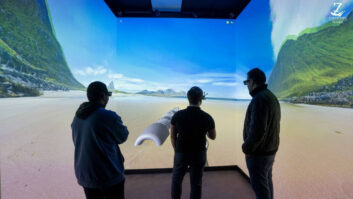
Virtual reality and related technologies are poised for big things across all sectors of the B2B world, says Chris Mcintyre-Brown of Futuresource Consulting.
In our work looking at virtual reality and related technologies*, we have highlighted a number of factors stimulating adoption in B2B applications across multiple industries. But first, some definitions. Futuresource defines virtual reality (VR) as an experience that fully immerses a user in an alternative reality through the use of a head-mounted display (HMD); mixed reality (MR) uses headsets or glasses to layer virtual elements over the existing world without fully immersing the user; augmented reality (AR) also layers virtual elements over the real world, but is viewed through a mobile device.
VR, MR and AR provide a vast opportunity for both B2B- and B2C-focused businesses. These rich, interactive video formats can convey product and service propositions in a more compelling and engaging way than 2D content – whether the communication goal is to entertain, evaluate or educate.
Advances in technology and falling component costs have made VR available to the mass market. In addition to consumer headsets, manufacturers have also distributed developer kits to drive education in the design and creative communities, helping develop expertise in content creation while also increasing consumer and B2B awareness.
Aeronautics, retail, architecture
Virtual reality in the B2B arena is not new: immersive caves, simulators and power walls have been around for many years. For example, aeronautical manufacturers have used digital CAD packages since the 1990s and are moving towards ever more sophisticated 3D modelling. Now, these 3D assets can be extended into a virtual world.
At Boeing, CAD assets have been taken into a virtualised training environment to teach new engineers skills before they ever reach the physical aircraft, for continuous personal development or for onsite ‘virtual manuals’. That same asset can be used by designers to amend designs and provide spatial awareness for ergonomic testing. It can also be an important tool in the sales process, lifting the design off the page (or out of the screen), giving a new sense of scale and perspective. AR or MR can blend new and older assets to become part of a training or sales tool, and repurpose them again to serve as an interactive video display or corporate communication training tool.
There are also interesting opportunities in retail. Take for example kitchen or bathroom suppliers, which offer a typically bland in-store point-of-sale experience. VR can add not just a wow factor but, again, a sense of scale and perspective, zooming in to highlight product USPs. Many retail stores already have online 3D packages where consumers can personalise designs by inputting simple dimensions from their homes. AR can further complement this environment: Ikea customers can already bring a virtual piece of furniture to life using AR via its catalogue, getting the ability to view the furniture in the home. It seems likely a more immersive VR and MR experience will follow.
In construction and architecture CAD already allows planners to speed up the planning process, visualising what a project such as a sports stadium may look like prior to development and provide the opportunity to gain input and amend designs before construction takes place. Again taking this a virtual step further would enhance engagement by town planners or investors in the virtual world.
HMDs will be an incredibly powerful differentiator for higher-end brands or businesses, and the technology is already there. In many instances, it is really more a period of waiting for the installed base of consumer HMDs to build, along with awareness, before retailers and businesses invest seriously in VR extensions.
Meeting of minds?
It is interesting to think about how the worlds of consumer entertainment and B2B verticals might merge in terms of the VR, MR and AR production and the tools, encoding, products and creative processes used. They might seem like separate industries but they could cross-pollinate, especially with some VR and AR playback products and technologies and content becoming more mainstream. While the potential offered to the consumer is extremely attractive, B2B application arguably offers more immediate and often more lucrative opportunities for these early innovator developers.
In B2B, VR, MR and AR all have their place: choose any vertical and there is a potential usage model for them. This is a completely different way to engage with digital content and one that we believe will bring the B2B sector a huge range of benefits.
*The new Futuresource Global Market Report Virtual Reality is now available.
Chris Mcintyre-Brown is associate director, displays & broadcast equipment at Futuresource Consulting.






